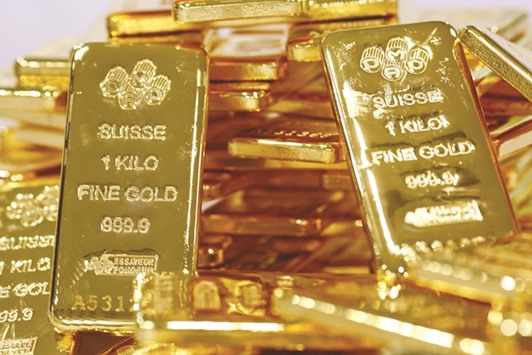Investors are falling back in love with gold thanks to the woman who came between them in the first place: Janet Yellen.
A rally in prices this month has the precious metal nearing a bull market for the first time since 2013 amid mounting expectations that Federal Reserve Chair Yellen won’t follow through on her forecast for raising US interest rates further this year. The prospect of lower-than-expected borrowing costs - - along with weakening equity and currency markets - is reviving gold’s appeal as a store of value.
Global gold holdings in exchange-traded funds (ETFs) also are climbing. The assets have swelled by 203.7 metric tons since the start of the year to 1,665.2 tons, heading for the biggest quarterly increase since the three months ended in June 2010, data compiled by Bloomberg show.
Futures in New York settled at $1,247.80 on February 11, 19% higher than the closing low reached in December. That left the metal just shy of a 20% gain that meets the common definition of a bull market.
After shunning the metal for three straight years, investors are coming back in droves. Inflows into exchange-traded funds tracking precious metals are heading for the biggest monthly increase since 2011, data compiled by Bloomberg show. Prices have rebounded as much as 21% since touching a five-year low in December, when the Fed boosted interest rates for the first time in almost a decade and signalled that the central bank planned further increases throughout 2016. Shares of gold-mining companies are surging, with Barrick Gold Corp trading near its highest since September 2014.
“We’re positioned for a bull market in gold,” said Jeff Sica, who helps oversee $1.5bn as founder and president of Circle Squared Alternative Investments in Morristown, New Jersey. “With the amount of volatility in the market, there’s going to be continued strength in gold,” Sica said in a telephone interview. “It’s obvious that even if the interest rates do move, they’re not going to move up quickly, and there’s greater likelihood that they may even stay the same or decline.”
Traders are pricing in less than 50% odds that the Fed will raise rates by December, down from 93% at the start of 2016. A slowdown in China has spurred a plunge in global equity markets this year amid concern over contagion from the world’s second-largest economy.
Yellen told Congress this month that market turbulence may weigh on the growth outlook. The Citigroup Economic Surprise Index showed US data as of Feb. 5 were falling short of expectations by the most in about eight months.
Gold has become the haven of choice, with futures up 15% this year in New York to $1,219.40 an ounce, dwarfing the 3% gain in US treasuries.
Slowing growth also is eroding the strength of the dollar, boosting the appeal of alternative asserts, including gold. And as the pessimistic outlook decreases the odds of increases for US interest rates, which were near zero% for seven years, bullion becomes more competitive against interest-bearing bonds. All that adds up to money pouring into the precious metals.
“The biggest story has been the strength in gold around this, more than anything else,” said Rob Haworth, a Seattle- based senior investment strategist at US Bank Wealth Management, which oversees $128bn of assets. “While it’s been haven flows, it’s also been retail investors looking for anything moving higher because it’s been a struggle last year to be an owner of stocks or any other risky assets.”
Investors are searching for value after almost $15tn was wiped from global equities since their peak in June. As of Monday, inflows into US ETFs backed by precious metals reached $3.147bn this month, heading for the biggest expansion since November 2011. That compares with $11.4bn flowing out of international and domestic equities so far in February, according data compiled by Bloomberg. All asset classes reported net outflows this year except for commodities and fixed income.
Money managers are expanding bullish bets after bailing last month on bets that prices would fall. Over the past three weeks, speculators almost quadrupled their net-long position in gold to 93,934 futures and options, US government data show. Wagers on price gains have climbed for seven straight weeks, the longest streak since 2012. Before January 12, they were net-short with bearish holdings for eight straight weeks. The Bloomberg World Mining Index has jumped 17% in February, snapping three months of declines.
Sustained gains for gold will depend on the continuation of a “fear trade,” said John LaForge, a Sarasota, Florida-based co- head of real assets at the Wells Fargo Investment Institute, which oversees $1.7tn.
Analysts remain split. Goldman Sachs Group said it’s time to bet against the precious metal. Prices will slump to $1,100 in three months, and $1,000 in 12 months, analysts including Jeffrey Currie and Max Layton wrote in a report February 15. Prices on average will be less than they are now in each of the next four quarters and all of next year, according to the median forecasts of 23 analysts tracked by Bloomberg.
But the slowing global economy and fading expectations for Fed action are prompting some analysts to revise their outlooks.
Itau Unibanco Holding, the third-most-accurate gold forecaster tracked by Bloomberg as of the fourth quarter, said prices will reach $1,100 on December 31, up from its previous estimate of $1,050.
The bank said the Fed will raise interest rates three times this year rather than four. Toronto-Dominion Bank, the second-most accurate precious-metals forecaster tracked by Bloomberg, boosted its second-quarter estimate to $1,225 from $1,100.

Gold has become the haven of choice, with futures up 15% this year in New York to $1,219.40 an ounce, dwarfing the 3% gain in US treasuries


